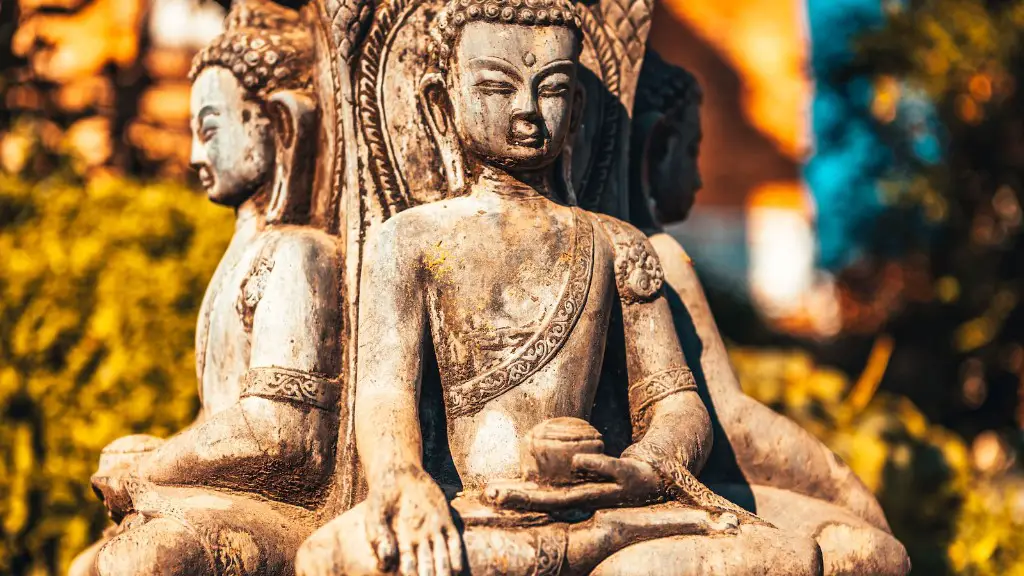Definitions
Buddhism is a spiritual-ethical tradition or school of thought, often described as a way of life or practice. Its core philosophy is based on the teachings of the enlightened Siddhartha Gautama, often referred to as the Buddha or ‘Awakened One’. The practice of Buddhism focuses on inner observation and meditation as the means to healing suffering and the attainment of peace, equanimity, and ultimate transcending of the cycle of suffering.
Christianity, on the other hand, is a monotheistic religion founded on the teachings of Jesus Christ. Central to this faith is a belief in the divinity of Jesus, as well as personal conversion, repentance of sin, and atonement for wrongdoing through faith in God’s grace and mercy. It also places emphasis on sharing and living out God’s love in their own lives, and working to make the world a better place through prayer and service.
Can You Practice Buddhism And Christianity?
The question of whether or not it is possible to practice Buddhism and Christianity simultaneously has been debated among religious scholars, theologians, and everyday practitioners for decades. To answer this question definitively is difficult, as it largely depends on the individual’s interpretation of how the two traditions relate to each other and what aspects of each they choose to embrace.
Broadly speaking, the two traditions have key differences in their core beliefs and fundamental doctrines. Buddhism does not focus on the divinity of a single figure such as Jesus – instead, it focuses on the path to enlightenment and the ending of suffering – but Christianity does emphasize the importance of faith in the divine, as well as key rituals and moral laws. On a deeper level, Buddhism emphasizes personal exploration of one’s inner world, while Christianity more often follows a set of doctrines and rules. Therefore, someone who practices both could potentially view them as two distinct paths to achieving peace and understanding.
In fact, many Buddhists see Christianity as an extension of Buddhism, and believe that Jesus’s teachings were based upon core Buddhist principles such as ahimsa (non-harming) and non-attachment. Likewise, many Christians view Buddhism as a beginner’s level introduction to the spiritual life and see Jesus’s teachings as an advancement of the principles taught by the Buddha. Therefore, it is difficult to definitively answer whether or not it is possible to practice both Buddhism and Christianity at the same time.
From the perspective of religious sociologists, there are several different potential paths a person would need to take in order to successfully practice both Buddhism and Christianity simultaneously. The first, and most commonly discussed path, is that of ‘syncretism’: integrating different religious beliefs and practices into a single faith. This is what most people who attempt to practice both tend to do – picking and choosing aspects of each tradition that best suit them personally, and blending them together into a hybrid of the two.
The second path, often undertaken by more advanced practitioners, is one of ‘transcendence’. This involves looking past the differences between the two traditions and seeing them as two paths to the same goal – that of achieving spiritual enlightenment. They may still choose to practice certain aspects of each, but they do so with a sense of ‘openness’ and ‘flexibility’, viewing each in light of the other.
Ultimately, the decision on whether or not to practice both Buddhism and Christianity simultaneously is a highly personal one and must be made with an individual’s personal preferences and convictions in mind. Only when these are considered can a successful path be determined.
Synthesis and Comparison
When looking at Buddhism and Christianity side-by-side, it is easy to see why it may be difficult to practice both simultaneously. The two paths delve into drastically different spiritual worlds and involve completely distinct systems of belief. For example, Buddhism focuses on the individual’s inner world, while Christianity tends to focus on external rules and practices. Similarly, the two religions have completely different concepts of salvation and the journey leading to it.
Despite these differences, however, it is possible to see some similarities between the two. Both place a strong emphasis on the importance of love and altruism, as well as personal responsibility. Furthermore, each tradition also contains aspects of meditation and contemplative practice. By combining these shared elements, it is possible to create an approach grounded in both Buddhist and Christian principles.
Additionally, looking at the different branches within the two main traditions can offer further insight. For example, some sects of Buddhism place less emphasis on personal enlightenment, and more on community-oriented behaviours such as social ethics. Likewise, some forms of Christianity focus less on external rules, and more on the life of faith. By looking for elements that are shared or similar between these different branches, it is possible to create a holistic practice that incorporates both.
Practicing Buddhism and Christianity in Harmony
Practising Buddhism and Christianity need not be an either/or situation. It is possible to find harmony between the two paths, while still holding to the core values of each. One way to do this is by embracing a ‘Polytheistic Perspective’ – that is, taking elements from each tradition, and seeing how they interrelate and complement each other. For those who practice in this way, each tradition can inform and enhance the other, allowing for both a deeper understanding of one’s own faith and life, as well as a greater appreciation for that of others.
For those who wish to practice both Buddhism and Christianity in perfect harmony, it is also essential to practice discernment. By recognizing the inherent differences between the two, as well as the different interpretations of the scriptures within each, one can use these differences to create a framework for understanding. This framework can help guide and inform one’s practice, while still allowing for maximal personal growth.
Furthermore, one must understand the fundamental differences in terms of practice. For example, Buddhism generally emphasizes greater inward focus and meditative practices, while Christianity steers more towards outward showings of faith such as prayer, charity, and service to others. Thus, a balance between the two must be found in order to maximize the spiritual benefits of both.
Personal Reflection
When looking at the question of whether or not it is possible to practice Buddhism and Christianity simultaneously, personal experience can be a key source of insight. By reflecting on one’s own spiritual journey and understanding of the two paths, any individual can come to their own conclusion on the matter. Everyone’s personal situation is unique, and there is no one-size-fits-all answer; this is why it is important for each individual to reflect and explore the possibility for themselves.
Ultimately, if one feels that it is possible for them to practice both Buddhism and Christianity at the same time, it is essential to remain open and accepting of both traditions. The key is to treat each with equality and respect, and never to allow the differences to override the core values of both. By finding a balance between the two paths, and embracing the unique qualities of each, it is possible to create an integrated practice that offers something of value to both practitioners.
Implications For Society
The implications of being able to successfully practice both Buddhism and Christianity is far-reaching. On a personal level, it provides an opportunity to explore two distinct paths of spiritual growth, while still maintaining the core values of each. On an interpersonal level, it provides a means of reconciling two distinct religious beliefs by engaging in thoughtful dialogue, understanding, and respect. On an international level, it serves to further the cause of global harmony and understanding among different cultures and faiths.
Furthermore, a unified approach to spirituality offers the potential to bring more people together within different religious communities. For example, it could provide a means of finding common ground between Buddhists and Christians, as well as practitioners of other faith traditions. By exploring together the shared themes that exist among different spiritual paths, it is possible to foster greater harmony and understanding within and between different faiths.
Finally, being able to practice both Buddhism and Christianity simultaneously also serves to remind us of the fundamental unity of all life. By bridging the different paths of spirituality, we can gain a deeper understanding of our own internal experience and the outer world around us. In a time marked by division and conflict, the power of a unified approach to spiritual practice cannot be underestimated.
Inner Work and Integration
In order to achieve a truly integrated approach to spirituality, one must be willing to do the inner work that is necessary for personal growth and transformation. This requires time, effort, and dedication to exploring one’s own internal landscape and fully engaging in the spiritual practices of both Buddhism and Christianity. Such inner exploration can require a great deal of courage and openness, but the rewards can be immense.
In terms of the practice itself, this may involve engaging in mindful meditation, journaling, and various rituals and spiritual disciplines from both the Hindu and Christian traditions. Additionally, it can involve deepening one’s understanding of the core teachings of both Buddhism and Christianity, taking into account the various interpretations of scripture, and exploring the ways in which they are related to one another.
In essence, the successful practice of both Buddhism and Christianity is a journey of self-discovery, integration and transformation. By embarking on this journey, the potential of a unified approach to spirituality can be fully realized.
Living the Synthesis of Buddhism and Christianity
Coming to a fully integrated approach to spirituality takes commitment and practice. For many, this process may require time, patience and dedication, but the results can be a profound deepening of one’s spiritual understanding and experience. As one engages in the practices from both Buddhism and Christianity, one has the potential to gain a greater appreciation for the interconnectedness of all things, as well as a more profound understanding of the oneness of all existence.
Living this synthesis comes with the knowledge that both Buddhism and Christianity have the capacity to bridge the gap between the inner and the outer world. By engaging in their practices together, one can come to a place of greater insight, awakening and understanding. Ultimately, it is up to each individual to determine how best to practice both faiths in harmony, and how to live a life of integration that best serves their own spiritual growth.


